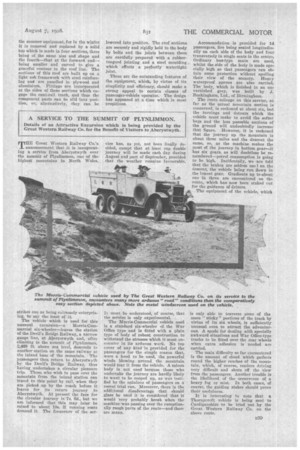PASSENGER TRAVEL NEWS.
Page 56

Page 57

If you've noticed an error in this article please click here to report it so we can fix it.
The Latest Doings and Developments in the Bus and Coach World.
A NEW IDEA IN ALL-WEATHER BODIES.
A Metcalfe Design in which the Ordinary Folding Hood is Displaced by a Solid Roof Built in Sections.
THE summer coaching season is now at its height, but in a few weeks' time the flow of excursion traffic will be slowing down appreciably and the thoughts of many coach proprietors who believe in the possibility of all-theyear-round operation, but on a reduced basis in the winter months, will be concerned with plans for encouraging winter travel. Experience of recent years rather suggests that our climate is becoming more equable and that temperatures as between distinct seasons are not nearly so marked, thus prompting the belief that winter coaching is quite a practicable proposition if the right type of vehicle be available.
• But what is the right type of vehicle? It is obviously one that is, or can be, all-enclosed. If it be the former it is passible that it would hardly be as attractive during the summer months as a vehicle with a folding hood, and, if it be the latter, it must not be possible to label it as a makeshift, for the conversion of a semiopen type to an all-enclosed vehicle must be well done if the passengers' comfort is not to suffer in the winter months.
Efforts have been made by several well-known concerns to provide a satisfactory type of body which will enable a vehicle to give comfort and convenience under all-the-year-round conditions of operation, and a further contribution to the solution of the problem has just been made by Metealfes, London, Ltd., 101, Regent Street, London, W.1,. the established coachbuilder, which has devised a method of construction having interesting features and distinct possibilities.
The idea is very simple and the conversion of the vehicle from one guise to another can be quickly carried out, For normal summer use the vehicle is employed—as shown in the uppermost illustration in the accompanying group —with a folding type of hood built on the lines of the orthodox pattern with boopsticks supporting a waterproof material. In this form the body does not differ materially from accepted allweather coach construction, but the method of its adaptation as an allenclosed model for winter use is new and unusual.
B3S We will briefly describe the body as fitted to a Mendslay ML3a chassis, i.e.. the vehicle forming the subject of the accompanying pictures. It is a 26seater, and, without considering the excellence of the all-weather equipment, it is a high-class product clearly reflecting modern tendencies in design. The sides of the body are extended to within 18 ins, of the,ground level, thus dispensing with the need for running boards, which are hardly needed on a vehicle having doors at the front and rear only, and are often liable to damage. Mounting steps are constructed in the framework and are enclosed by the doors, each of which is wide and hung on four hinges.
The fratnework is built of ash, steel reinforcement being used at vulnerable parts. The side pillars are of fairly narrow section and, as the windows are wide, a good view is given at the sides. The full-width side windows, including those in the doors, can all be lowered, and their operation is controlled by Rawlings rod-type fittings located on
the top of the garnish rail. Louvre ventilators are fitted above each side light.
Most of the seats are of the transverse type, each to seat two people, but there is a longitudinal seat on each side • above the rear wheel-arches. The seats themselves are of semi-bucket design with high, rigid backs and they are well-sprung and upholstered, the cushions being deep and detachable. The seat backs are covered with a pile carpet and pockets intended for the reception of newspapers, etc., are incorporated in them. The woodwork of the interior is polished throughout and is inlaid at the garnish rails and at other suitable parts.
Let us now deal with the all-weather equipment. At the rear of the body is a fairly shallow domed section, which is permanent, and it is against the front end of its roof that the roof-sticks of the -.ordinary hood covering rest when they are not in use. The steel roofsticks have roller ends, running in a brass trap on the cant-rails and can easily be slid forward or backward as required; when in the latter position, the sticks and the hood material fold neatly in front of the domed section and are enclosed in an envelope.
This constitutes what may be termed
the summer equipment, for in the winter it is removed and replaced by a solid _ top which is made in. four sections, three being of the same size and shape and the fourth—that at the forward end— being smaller and curved to give a graceful contour to the roof line. The sections of this roof are built up on a light ash framework with steel reinforcing and are panelled in plywood and aluminium. Fittings are incorporated at the sides of these sections which engage the cant-rail track, and thus the component parts can be slid into position, or, alternatively, they can be
lowered into position. The roof sections are securely and rigidly held to the body by bolts and the joints between them are carefully prepared with a rubbertongued jointing and a steel moulding which effects a perfectly watertight joint.
These are the outstanding features of the equipment, which, by virtue of -its simplicity and efficiency, should make a strong appeal to certain classes of passenger-vehicle operator. The design has appeared at a time which is most propitious.




































































































